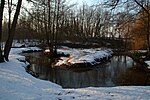The Battle of Pavia, fought on the morning of 24 February 1525, was the decisive engagement of the Italian War of 1521–1526 between the Kingdom of France and the Habsburg Empire of Charles V, Holy Roman Emperor as well as ruler of Spain, Austria, the Low Countries, and the Two Sicilies.
The French army was led by King Francis I of France, who laid siege to the city of Pavia (then part of the Duchy of Milan within the Holy Roman Empire) in October 1524 with 26,200 troops. The French infantry consisted of 6,000 French foot soldiers and 17,000 foreign mercenaries: 8,000 Swiss, 5,000 Germans, and 4,000 Italians (black bands). The French cavalry consisted of 2,000 gendarmes and 1,200 lances fournies. Charles V, intending to break the siege, sent a relief force of 22,300 troops to Pavia (where the Imperial garrison stationed consisted of 5,000 Germans and 1,000 Spaniards) under the command of the Fleming Charles de Lannoy, Imperial lieutenant and viceroy of Naples, and of the French renegade and captain-general Charles III, Duke of Bourbon. The Habsburg infantry consisted of 12,000 German Landsknechte, 5,000 Spaniards, and 3,000 Italians, and its command was exercised by an Italian Condottiero, the Marquis of Pescara, in conjunction with the German military leader Georg Frundsberg and the Spanish captain Antonio de Leyva who was in charge of the Imperial garrison inside Pavia. The cavalry, led by Lannoy and Bourbon, consisted of 1,500 knights and 800 lances.The battle was fought in the Visconti Park of Mirabello di Pavia, outside the city walls, where Pescara and Frundsberg stationed their forces in pike and shot formation. Francis took a personal initiative and led a cavalry charge against Lannoy, with the possible intent of capturing Bourbon, but it was held by German and Spanish pikemen and ravaged by arquebus fire. The arquebusiers formed a part of the Spanish colunellas and of the German doppelsöldners. A mass of Spanish and German foot soldiers descended on the French cavalry from all sides and began systematically killing the French gendarmes. The remaining French forces, including Swiss mercenaries and Black bands, intervened to protect the King but were surrounded by the pikemen in front of them and by the garrison of Pavia that sortied from the town.
In the four-hour battle, the French army was split and defeated in detail. Many of the chief nobles of France were killed, and others – including Francis I himself – were captured. He was imprisoned in the nearby tower of Pizzighettone and later transferred to Spain, where Charles V was residing for his upcoming marriage with Isabella of Portugal. Together they signed the Treaty of Madrid of 1526, by which Francis abandoned claims over the Imperial Duchy of Milan and ceded Burgundy to the House of Habsburg in exchange for his freedom.
The outcome of the battle cemented Habsburg ascendancy in Italy and Europe, but Francis denounced the treaty after his liberation and soon re-opened hostilities over Burgundy and Milan.








